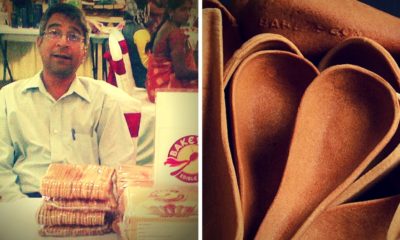Top News
Hyderabad never sleeps during Ramadan

Hyderabad: It is past midnight but the traffic is moving at snail’s pace. Scores of people are in their cars, parked on both sides of the road and relishing the haleem, a Ramadan delicacy.
Dozens of young waiters of Pista House and Shah Ghouse, the two popular haleem makers, are on their feet, vying with each other to serve customers on the busy Toli Chowki-Mehdipatnam stretch.
Shoppers, the faithful returning from mosques, techies heading home from IT hubs, and families throng the dozens of food joints serving piping hot haleem. Heavy traffic, illuminated shops, and crowded hotels and eateries give one a feeling that it is day time.
And this is not the old city. So, the situation in the famous markets around the historic Charminar can well be imagined.
With only days to go for Eid-ul-Fitr, Ramadan shopping in this historic city with a rich Islamic heritage has reached a feverish pitch. While the city witnesses unprecedented commercial activity during the entire holy month, it hardly sleeps in the last 10 days.
The devout converge at mosques for ‘namaz-e-taraveeh’ around 8.30 p.m. and the night vigil ends with special prayers ‘tahajjud’ around 3.30 a.m. They make most of the last days to offer prayers and seek forgiveness from the Almighty — the goal of the holy month.
For most families, it’s also the time for Eid shopping.
From new clothes and footwear to bangles, mehndi, ‘attar’ (natural perfumes), crockery, household items and vermicelli and dry fruits, they buy everything.
Shops in the centuries-old markets in the old city and the gleaming malls in the central and new Hyderabad are packed with men, women and children.
As people feel tired due to fasting during the day and hardly find any time to spare in the evenings, the shopping is mostly done after 8 p.m. — and it continues till ‘sehr’ or the pre-dawn meals.
Dates and all varieties of fruits flood the market during the entire month as Muslims prefer it for ‘iftar’ or breaking the fast.
Thousands of vendors set up businesses on the footpaths in areas surrounding Charminar in the old city. In recent years, Nampally, Mallepally, Masab Tank, Asif Nagar, Mehdipatnam, Masab Tank, Toli Chowi, Golconda and other Muslim majority areas outside the old city have been witnessing hectic commercial activity during Ramadan.
Hyderabad is the hot favourite among Eid shoppers, including many who come from other parts of Telangana and neighbouring Andhra Pradesh, Maharashtra and Karnataka.
With well-to-do families paying ‘zakat’ (Islamic wealth tax of 2.5 percent on their cash and other valuables) and almost every family paying ‘fitra’ (fixed this year at Rs.100 per member), the poor also join the festivities by buying clothes, ‘sweyian’, dry fruits and other items for ‘sheer khorma’ — a sweet dish prepared on Eid.
With Muslims accounting for about 30 percent of the city’s estimated nine million population, every commodity associated with the festivities opens up huge business opportunities during the month.
The volume of business, which is mostly in the unorganised sector, is beyond anybody’s guess. According to some estimates, the business covering eatables, garments and footwear alone exceeds Rs.2,000 crore.
Such is the economic spin-off of Ramadan that thousands of people get additional income by setting up makeshift shops on footpaths to sell various items. The authorities also show leniency.
The city has no parallels in India when it comes to Ramadan. It’s no wonder that many Hyderabadis who live abroad make it a point to visit home on Eid.
“You don’t get to see this atmosphere in any other part of the world,” said Mohammed Jaffer, an Indian American who has come home with his family to be part of the grand festivities.
“When it’s Ramadan, we make sure that we spend it here,” Zaki Ahmed, who lives in Abu Dhabi with his family, told IANS. It is also an occasion for the techie to be with his parents to celebrate Eid.
Many NRIs visit mosques like Azizia Masjid in Mehdipatnam for the night prayers and to hear the sermons from eminent religious scholars.
They point out that it is the mix of both the religious activities and the unique Hyderabadi culture which make Ramadan so special here.
Entertainment
Casino Days Reveal Internal Data on Most Popular Smartphones

International online casino Casino Days has published a report sharing their internal data on what types and brands of devices are used to play on the platform by users from the South Asian region.
Such aggregate data analyses allow the operator to optimise their website for the brands and models of devices people are actually using.
The insights gained through the research also help Casino Days tailor their services based on the better understanding of their clients and their needs.
Desktops and Tablets Lose the Battle vs Mobile
The primary data samples analysed by Casino Days reveal that mobile connections dominate the market in South Asia and are responsible for a whopping 96.6% of gaming sessions, while computers and tablets have negligible shares of 2.9% and 0.5% respectively.
The authors of the study point out that historically, playing online casino was exclusively done on computers, and attribute thе major shift to mobile that has unfolded over time to the wide spread of cheaper smartphones and mobile data plans in South Asia.
“Some of the reasons behind this massive difference in device type are affordability, technical advantages, as well as cheaper and more obtainable internet plans for mobiles than those for computers,” the researchers comment.
Xiaomi and Vivo Outperform Samsung, Apple Way Down in Rankings
Chinese brands Xiaomi and Vivo were used by 21.9% and 20.79% of Casino Days players from South Asia respectively, and together with the positioned in third place with a 18.1% share South Korean brand Samsung dominate the market among real money gamers in the region.
Cupertino, California-based Apple is way down in seventh with a user share of just 2.29%, overshadowed by Chinese brands Realme (11.43%), OPPO (11.23%), and OnePlus (4.07%).
Huawei is at the very bottom of the chart with a tiny share just below the single percent mark, trailing behind mobile devices by Motorola, Google, and Infinix.
The data on actual phone usage provided by Casino Days, even though limited to the gaming parts of the population of South Asia, paints a different picture from global statistics on smartphone shipments by vendors.
Apple and Samsung have been sharing the worldwide lead for over a decade, while current regional leader Xiaomi secured their third position globally just a couple of years ago.
Striking Android Dominance among South Asian Real Money Gaming Communities
The shifted market share patterns of the world’s top smartphone brands in South Asia observed by the Casino Days research paper reveal a striking dominance of Android devices at the expense of iOS-powered phones.
On the global level, Android enjoys a comfortable lead with a sizable 68.79% share which grows to nearly 79% when we look at the whole continent of Asia. The data on South Asian real money gaming communities suggests that Android’s dominance grows even higher and is north of the 90% mark.
Among the major factors behind these figures, the authors of the study point to the relative affordability of and greater availability of Android devices in the region, especially when manufactured locally in countries like India and Vietnam.
“And, with influencers and tech reviews putting emphasis on Android devices, the choice of mobile phone brand and OS becomes easy; Android has a much wider range of products and caters to the Asian online casino market in ways that Apple can’t due to technical limitations,” the researchers add.
The far better integration achieved by Google Pay compared to its counterpart Apple Pay has also played a crucial role in shaping the existing smartphone market trends.
Content provided by Adverloom

























